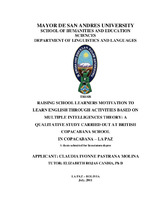Raising school learners motivation to learn english through activities based on multiple intelligences theory: a qualitetive study carried out a british Copacabana School in Copacaba - La Paz
Fecha
2011Autor
Pastrana Molina, Claudia Ivonne
Rojas Candia, Elizabeth (Tutora)
Metadatos
Mostrar el registro completo del ítemResumen
Motivation is a key element in language learning as it determines the success of it. The lack of motivation originates a sense of failure from the learner’s point of view. In fact, considering this, different studies have studied the role of motivation in language learning from different perspectives; that is the case of Howard Gardner, who provides an answer to improve learner’s motivation in his theory called Multiple Intelligence Theory (MIT). Gardner explains that people have different types of intelligences and states nine intelligences: Verbal-linguistic, Logical-mathematical, Visual-spatial, Bodily-kinaesthetic, Musical-rhythmic, Intrapersonal, Interpersonal, Naturalist, and Existentialist intelligence; its educational application would raise students’ motivation to learn English language.
Hence, the main purpose of this work is to describe how activities and classroom management based on Howard Gardner’s Multiple Intelligences psychological theory could help to improve and raise students’ motivation to learn English language at school in students from 8th grade of primary level to 2nd grade of secondary level at British Copacabana School in Copacabana La Paz. In so doing, nine activities are designed and used in actual teaching and classroom: “To write sentences” ,“to write conversations”, “To perform conversations”, “To solve the puzzle”, “to watch a video”, “to listen to a song”, “to draw what they read”, “to speak with tourists” and “to write about pollution in Copacabana”. On the whole, the study reports important findings such as: Students got more motivated doing speaking activities than writing activities. The attractiveness of activities become an important factor which influenced students to carry out activities. And students realized about their strengths and weaknesses and how to take advantage of that.
Consequently, this research is developed into five important chapters: Chapter I describes the problem and states the research questions that guide the study. Chapter II is intended to explain the theoretical foundations that support the present research on Multiple Intelligences Theory related to motivation. Chapter III describes first, the research method and procedures to collect data; after that, it describes the data organization through a categorization process. Chapter IV explains the results` interpretation and the mayor findings such as emerging hypothesis. Finally, chapter V ends with some conclusions and recommendations for teachers and forthcoming studies.

